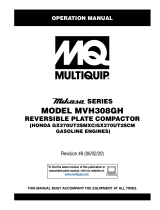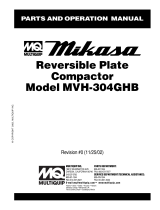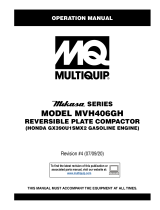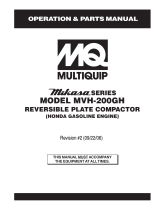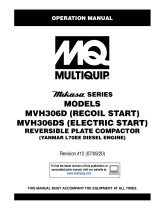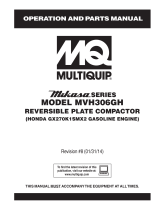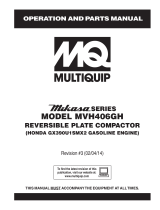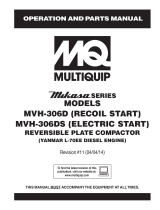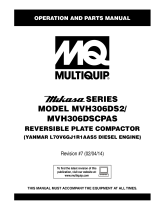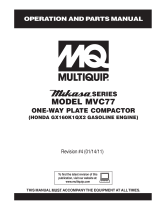Page is loading ...

OPERATION MANUAL
THIS MANUAL MUST ACCOMPANY THE EQUIPMENT AT ALL TIMES.
Revision #9 (07/09/20)
SERIES
MODEL MVH306GH
REVERSIBLE PLATE COMPACTOR
(HONDA GX270K1SMX2 GASOLINE ENGINE)
To find the latest revision of this publication or
associated parts manual, visit our website at:
www.multiquip.com

PAGE 2 — MVH306GH PLATE COMPACTOR — OPERATION MANUAL — REV. #9 (07/09/20)
PROPOSITION 65 WARNING

MVH306GH PLATE COMPACTOR — OPERATION MANUAL — REV. #9 (07/09/20) — PAGE 3
MIKASA MVH306GH
REVERSIBLE PLATE
COMPACTOR
Proposition 65 Warning ..............................................2
Table Of Contents ...................................................... 3
Safety Information .................................................. 4-9
Specifications ...........................................................10
Dimensions ..............................................................11
General Information .................................................12
Components.............................................................13
Inspection ........................................................... 14-15
Operation ........................................................... 16-18
Maintenance ...................................................... 19-22
Troubleshooting (Engine) .........................................23
Troubleshooting (Compactor) ..................................24
TABLE OF CONTENTS

PAGE 4 — MVH306GH PLATE COMPACTOR — OPERATION MANUAL — REV. #9 (07/09/20)
SAFETY INFORMATION
Do not operate or service the equipment before reading
the entire manual. Safety precautions should be followed
at all times when operating this equipment.
Failure to read and understand the safety
messages and operating instructions could
result in injury to yourself and others.
SAFETY MESSAGES
The four safety messages shown below will inform you
about potential hazards that could injure you or others. The
safety messages specifically address the level of exposure
to the operator and are preceded by one of four words:
DANGER, WARNING, CAUTION or NOTICE.
SAFETY SYMBOLS
DANGER
Indicates a hazardous situation which, if not avoided,
WILL result in DEATH or SERIOUS INJURY.
WARNING
Indicates a hazardous situation which, if not avoided,
COULD result in DEATH or SERIOUS INJURY.
CAUTION
Indicates a hazardous situation which, if not avoided,
COULD result in MINOR or MODERATE INJURY.
NOTICE
Addresses practices not related to personal injury.
Potential hazards associated with the operation of this
equipment will be referenced with hazard symbols which
may appear throughout this manual in conjunction with
safety messages.

MVH306GH PLATE COMPACTOR — OPERATION MANUAL — REV. #9 (07/09/20) — PAGE 5
SAFETY INFORMATION
GENERAL SAFETY
CAUTION
NEVER operate this equipment without proper protective
clothing, shatterproof glasses, respiratory protection,
hearing protection, steel-toed boots and other protective
devices required by the job or city and state regulations.
NEVER operate this equipment when not
feeling well due to fatigue, illness or when
under medication.
NEVER operate this equipment under the influence of
drugs or alcohol.
ALWAYS check the equipment for loosened threads or
bolts before starting.
DO NOT use the equipment for any purpose other than
its intended purposes or applications.
ALWAYS clear the work area of any debris, tools, etc.
that would constitute a hazard while the equipment is
in operation.
NOTICE
This equipment should only be operated by trained and
qualified personnel 18 years of age and older.
Whenever necessary, replace nameplate, operation and
safety decals when they become difficult read.
Manufacturer does not assume responsibility for any
accident due to equipment modifications. Unauthorized
equipment modification will void all warranties.
NEVER use accessories or attachments that are not
recommended by Multiquip for this equipment. Damage
to the equipment and/or injury to user may result.
ALWAYS know the location of the nearest
fire extinguisher.
ALWAYS know the location of the nearest
first aid kit.
ALWAYS know the location of the nearest phone or keep
a phone on the job site. Also, know the phone numbers
of the nearest ambulance, doctor and fire department.
This information will be invaluable in the case of an
emergency.

PAGE 6 — MVH306GH PLATE COMPACTOR — OPERATION MANUAL — REV. #9 (07/09/20)
SAFETY INFORMATION
COMPACTOR SAFETY
DANGER
NEVER operate the equipment in an explosive
atmosphere or near combustible materials. An
explosion or fire could result causing severe
bodily harm or even death.
WARNING
NEVER disconnect any emergency or safety devices.
These devices are intended for operator safety.
Disconnection of these devices can cause severe injury,
bodily harm or even death. Disconnection of any of these
devices will void all warranties.
CAUTION
NEVER lubricate components or attempt service on a
running machine.
NOTICE
ALWAYS keep the machine in proper running condition.
Fix damage to machine and replace any broken parts
immediately.
ALWAYS store equipment properly when it is not being
used. Equipment should be stored in a clean, dry location
out of the reach of children and unauthorized personnel.
ENGINE SAFETY
DANGER
The engine fuel exhaust gases contain poisonous carbon
monoxide. This gas is colorless and odorless, and can
cause death if inhaled.
The engine of this equipment requires an adequate
free flow of cooling air. NEVER operate this equipment
in any enclosed or narrow
area where free flow of the
air is restricted. If the air
flow is restricted it will cause
injury to people and property
and serious damage to the
equipment or engine.
WARNING
DO NOT place hands or fingers inside engine
compartment when engine is running.
NEVER operate the engine with heat shields or
guards removed.
Keep fingers, hands hair and clothing away
from all moving parts to prevent injury.
DO NOT remove the radiator cap while the
engine is hot. High pressure boiling water will gush out
of the radiator and severely scald any persons in the
general area of the compactor.
DO NOT remove the coolant drain plug
while the engine is hot. Hot coolant will
gush out of the coolant tank and severely
scald any persons in the general area of
the compactor.
DO NOT remove the engine oil drain plug while the
engine is hot. Hot oil will gush out of the oil tank and
severely scald any persons in the general area of the
compactor.
CAUTION
NEVER touch the hot exhaust manifold,
muffler or cylinder. Allow these parts to cool
before servicing equipment.
NOTICE
NEVER run engine without an air filter or with a dirty air
filter. Severe engine damage may occur. Service air filte
r
frequently to prevent engine malfunction.
NEVER tamper with the factory settings
of the engine or engine governor. Damage
to the engine or equipment can result
if operating in speed ranges above the
maximum allowable.
NEVER tip the engine to extreme angles during lifting as
it may cause oil to gravitate into the cylinder head, making
the engine start difficult.

MVH306GH PLATE COMPACTOR — OPERATION MANUAL — REV. #9 (07/09/20) — PAGE 7
SAFETY INFORMATION
FUEL SAFETY
DANGER
DO NOT add fuel to equipment if it is placed inside truck
bed with plastic liner. Possibility exists of explosion or
fire due to static electricity.
DO NOT start the engine near spilled fuel or combustible
fluids. Diesel fuel is extremely flammable and its vapors
can cause an explosion if ignited.
ALWAYS refuel in a well-ventilated area, away from
sparks and open flames.
ALWAYS use extreme caution when working with
flammable liquids.
DO NOT fill the fuel tank while the engine is running
or hot.
DO NOT overfill tank, since spilled fuel could ignite if it
comes into contact with hot engine parts or sparks from
the ignition system.
Store fuel in appropriate containers, in well-ventilated
areas and away from sparks and flames.
NEVER use fuel as a cleaning agent.
DO NOT smoke around or near the
equipment. Fire or explosion could result
from fuel vapors or if fuel is spilled on a
hot engine.
FUEL
FUEL
BATTERY SAFETY (ELECTRIC START ONLY)
DANGER
DO NOT drop the battery. There is a possibility that the
battery will explode.
DO NOT expose the battery to open flames,
sparks, cigarettes, etc. The battery contains
combustible gases and liquids. If these
gases and liquids come into contact with a
flame or spark, an explosion could occur.
WARNING
ALWAYS wear safety glasses when
handling the battery to avoid eye irritation.
The battery contains acids that can cause
injury to the eyes and skin.
Use well-insulated gloves when picking up
the battery.
ALWAYS keep the battery charged. If the battery is not
charged, combustible gas will build up.
DO NOT charge battery if frozen. Battery can explode.
When frozen, warm the battery to at least 61°F (16°C).
ALWAYS recharge the battery in a well-ventilated
environment to avoid the risk of a dangerous concentration
of combustible gases.
If the battery liquid (dilute sulfuric acid)
comes into contact with clothing or skin,
rinse skin or clothing immediately with
plenty of water.
If the battery liquid (dilute sulfuric acid) comes into
contact with eyes, rinse eyes immediately with plenty
of water and contact the nearest doctor or hospital to
seek medical attention.
CAUTION
ALWAYS disconnect the NEGATIVE battery terminal
before performing service on the equipment.
ALWAYS keep battery cables in good working condition.
Repair or replace all worn cables.

PAGE 8 — MVH306GH PLATE COMPACTOR — OPERATION MANUAL — REV. #9 (07/09/20)
SAFETY INFORMATION
TRANSPORTING SAFETY
CAUTION
NEVER allow any person or animal to stand underneath
the equipment while lifting.
NOTICE
Before lifting, make sure that the equipment parts (hook
and vibration insulator) are not damaged and screws are
not loose or missing.
Always make sure crane or lifitng device has been
properly secured to the lifting bail (hook) of the
equipment.
ALWAYS shutdown engine before transporting.
NEVER lift the equipment while the engine is running.
Tighten fuel tank cap securely and close fuel cock to
prevent fuel from spilling.
Use adequate lifting cable (wire or rope) of sufficient
strength.
Use one point suspension hook and lift straight
upwards.
DO NOT lift machine to unnecessary heights.
ALWAYS tie down equipment during transport by
securing the equipment with rope.
ENVIRONMENTAL SAFETY
NOTICE
Dispose of hazardous waste properly.
Examples of potentially hazardous waste
are used motor oil, fuel and fuel filters.
DO NOT use food or plastic containers to dispose of
hazardous waste.
DO NOT pour waste, oil or fuel directly onto the ground,
down a drain or into any water source.

MVH306GH PLATE COMPACTOR — OPERATION MANUAL — REV. #9 (07/09/20) — PAGE 9
etalPelbisreveRHG603-HVM.1elbaT
snoitacificepSrotcapmoC
ecroFlagufirtneC)gk206,4(bl521,01
ycneuqerFnoitarbiV)zH07(mpv004,4
deepSgnilevarT )nim/m32ot0(nim/tf57ot0
)
WxL(eziSetalP )mc63.68x27.54(ni43x81
)WxL(eziSetalPlanretxEhtiW )mc63.68x69.06(ni43x42
)snoisnetxeon(noit
capmoCfoaerA.xaM )sretem.qs750,2(.tf.qs057,6
htgneLllarevO)mm0751(ni8.16
htdiWllarevO)mm754(ni0.81
)eldnahh
tiw(thgieHllarevO)mm0211(ni1.44
)eldnahtuohtiw(thgieHllarevO)mm508(ni7.13
SD/DthgieWgnitarepO)gk603(.sbl37
6
)setalpnoisnetxehtiw(thgieWgnitarepO)gk123(.sbl607
snoitacificepSenignE.2elbaT
enignE
ledoM2XMS1K072XGADNOH
epyT
,rednilyCelgniS,ekortS-4
enignEenilosaG,VHO
ekortSXeroB
.ni3.2X.ni0.3
).mm8
5xmm77(
tnemecalpsiDmc072(ni-uc5.61
3
)
tuptuOxaM .M.P.R0063@)WK7.6(.P.H0.9
yticapaCknaTleuF)sretil0.6(snollag95.1
leuF enilosaGelibomotuAdedaeln
U
yticapaCliOebuL)sretil1.1(strauq61.1
dohteMlortnoCdeepS epyTthgiew-ylFlagufirtneC
dohteMgnitratStratSlioc
eR
noisnemiD
)HxWxL(
.ni1.61X9.61x0.41
).mm014X034X553(
thgieWteNyrD ).gK52(sbl1.55
SPECIFICATIONS

PAGE 10 — MVH306GH PLATE COMPACTOR — OPERATION MANUAL — REV. #9 (07/09/20)
Figure 3. MVH306GH Reversible Plate Compactor Dimensions
snoisnemiD.3elbaT
.FERSNOISNEMID
A).mc6.431(.ni35
B).mc64(.ni81
C).mc68(.ni43
D).mc261(.ni8.36
E).mc5.08(7.13
DIMENSIONS

MVH306GH PLATE COMPACTOR — OPERATION MANUAL — REV. #9 (07/09/20) — PAGE 11
Plate Compactor
The Mikasa MVH306GH is a walk behind, reversible plate
compactor designed for the compaction of sand, clay and
asphalt. This plate compactor is a powerful compacting tool
capable of applying a tremendous force in consecutive high
frequency vibrations to a soil surface. Its applications include
soil compacting for road, embankments and reservoirs as well
as backfilling for gas pipelines, water pipelines and cable
installation work.
Vibratory Plates
The vibratory plates of the MVH306GH produce low amplitude
high frequency vibrations, designed to compact granular soils.
The resulting vibrations cause forward motion. The engine and
handle are vibration isolated from the vibrating plate. The heavier
the plate, the more compaction force it generates.
Reversible Vibratory Plates
Reversible vibratory plates have two eccentric weights that allow
a smooth transition for forward and reverse travel, plus increased
compaction force as the result of dual weights.
Due to their weight and force, reversible plates are ideal for
semi-cohesive soils.
Frequency/Speed
The compactor's vibrating plate maximum frequency is 4400
vpm (vibrations per minute). The forward and reverse travel speed
of the compactor is approximately 75 ft./minute (23 meters/
minute).
Engine
The Mikasa MVH306GH Plate Compactor is equipped with a
GX270K1-SMX2 (recoil start) gasoline engine.
Controls
Before starting the MVH306GH Plate Compactor, identify and
understand the function of the controls and components as
indicated in Figure 4.
GENERAL INFORMATION

PAGE 12 — MVH306GH PLATE COMPACTOR — OPERATION MANUAL — REV. #9 (07/09/20)
Figure 4. MVH306GH Reversible Plate
Compactor Components
Figure 4 illustrates the location of the major components for the
MVH306GH Reversible Plate Compactor. The function of each
component is described below:
1. Hand Grip – When operating the compactor use this hand
grip to maneuver the compactor.
2. Forward & Reverse Lever –
Push
the lever forward, the
compactor will move in a forward direction,
pull
the lever
backwards, the compactor will move in backwards direction.
Placing the lever in the middle (midway) will cause the
compactor not to move (neutral).
3. Handle Bar – When operating the compactor, this handle
is to be in the downward position. When the compactor is
to be
stored
, move the handle bar to the upright position.
4. Guard Hook - Used to lift the machine with crane or other
lifting device.
5. Stopper - Locks the handle in place in the upward position
for stowing.
6. Engine – This plate compactor uses a GX270K1-SMX2
gasoline engine. Refer to the owner’s manual for engine
information and related topics.
7. Belt Cover – Remove this cover to gain access to the V-
belts. NEVER run the compactor without the V-belt cover. If
the V-belt cover is not installed, the possibility exist that
your hand may get caught between the V-belt and clutch,
thus causing serious injury and bodily harm.
8. Base Plate – Designed to compact sand, clay, and asphalt.
9. Oil Reservoir – Fill with Shell Tellus Oil 46 or equivalent
grade hydraulic oil.
10. Vibration Case – Encloses the eccentric, gears and
counter weights.
11. Hydraulic Cylinder – Activated by moving the travel lever.
The cylinder controls the direction of movement by the plate
compactor.
12. Shock Absorber – Protects plate compactor from damage
by absorbing vibration during operation.
13. Throttle Lever – Controls speed of the plate compactor.
Place straight vertically to start, push fully counterclockwise
for full throttle and fully clockwise to stop plate compactor.
14. Rubber Cover – Lift this rubber cover to gain access to
the fuel tank.
COMPONENTS

MVH306GH PLATE COMPACTOR — OPERATION MANUAL — REV. #9 (07/09/20) — PAGE 13
Figure 5. Honda GX270 Engine Components
INITIAL SERVICING
The engine (Figure 5) must be checked for proper lubrication and
filled with fuel prior to operation. Refer to the manufacturers engine
manual for instructions & details of operation and servicing. The
engine shown above is a HONDA engine, operation for other
types of engines may vary somewhat.
1. Fuel Filler Cap – Remove this cap to add unleaded
gasoline to the fuel tank. Make sure cap is tightened
securely. DO NOT over fill.
DANGER
2. Throttle Lever – Used to adjust engine RPM speed (lever
advanced forward
SLOW
, lever back toward operator
FAST
).
3. Engine ON/OFF Switch – ON position permits engine
starting, OFF position stops engine operations.
4. Recoil Starter (pull rope) – Manual-starting method. Pull
the starter grip until resistance is felt, then pull briskly and
smoothly.
5. Fuel Valve Lever – OPEN to let fuel flow, CLOSE to stop
the flow of fuel.
6. Choke Lever – Used in the starting of a cold engine, or in
cold weather conditions. The choke enriches the fuel
mixture.
7. Air Cleaner – Prevents dirt and other debris from entering
the fuel system. Remove wing-nut on top of air filter
cannister to gain access to filter element.
8. Spark Plug – Provides spark to the ignition system. Set
spark plug gap to 0.6 - 0.7 mm (0.028 - 0.031 inch) Clean
spark plug once a week.
9. Muffler – Used to reduce noise and emissions.
10. Fuel Tank – Holds unleaded gasoline. For additional
information refer to engine owner's manual.
BASIC ENGINE
WARNING
Add fuel to the tank only when the engine is
stopped and has cooled down. In the event
of a fuel spill, DO NOT attempt to start the
engine until the fuel residue has been
completely wiped up and the area
surrounding the engine is dry.
Engine components can generate extreme
heat. To prevent burns, DO NOT touch these
areas while the engine is running or
immediately after operating. NEVER operate
the engine with the muffler removed.
WARNING
Operating the engine without an air filter, with a damaged air
filter, or a filter in need of replacement will allow dirt to enter
the engine, causing rapid engine wear.
NOTICE

PAGE 14 — MVH306GH PLATE COMPACTOR — OPERATION MANUAL — REV. #9 (07/09/20)
Checking Engine Oil Level
1. To check the engine oil level, place the compactor on secure
level ground with the engine stopped.
2. Remove the dipstick from the engine oil filler hole (Figure 6)
and wipe it clean.
3. Insert and remove the dipstick without screwing it into the
filler neck. Check the oil level shown on the dipstick.
Before Starting
1. Read safety instructions at the beginning
of manual.
2. Familiarize yourself with the operating
and control elements of the machine
and the working environment. This includes obstacles in
the working area, bearing capacity of the ground and the
necessary safety provisions.
3. Check the air filter for dirt and dust. If air filter is dirty, replace
air filter with a new one as required.
4. Check fastening nuts and bolts for tightness. Loose threads
may cause damage to the machine when vibrating.
5. Understand the geographical features and regulations of
the job site.
6. Clean the compactor, removing dirt and dust. Particularly,
the bottom of the plate, engine cooling air inlet.
Figure 6. Engine Oil Dipstick Removal
4. If the oil level is low (Figure 7), fill to the edge of the oil filler
hole with the recommended oil type (Table 4). Maximum oil
capacity is 1.16 quarts (1.10 liters).
epyTliO.4elbaT
nosaeS erutarepmeT epyTliO
remmuS rehgiHroC°52 03-W01EAS
llaF/gnirpS C°01~C°52 02/03-W01EAS
retniW rewoLroC°0 01-W01EAS
Checking the Hydraulic Oil Level
1. To check the engine oil level, place the compactor on secure
level ground with the engine stopped.
2. Remove the hydraulic oil breather cap located at the top of the
hydraulic oil tank (Figure 8).
3. Using a 24 mm wrench, remove the hydraulic oil filler plug.
3. Visually inspect to determine if hydraulic oil level is low. If oil
level is low add Shell Tellus 46 hydraulic oil or equivalent
through the hand pump oil filler port.
Figure 8. Hydraulic Oil Filler Plug Removal
Figure 7. Engine Oil Level
INSPECTION
ALWAYS wear approved eye and hearing
protection before operating the compactor.
CAUTION
NEVER operate the compactor in a
confined area or enclosed area structure
that does not provide ample
free flow of
air
.
CAUTION

MVH306GH PLATE COMPACTOR — OPERATION MANUAL — REV. #9 (07/09/20) — PAGE 15
Checking The Fuel
1. Remove the fuel cap located on top of fuel tank.
2. Visually inspect to see if fuel level is low. If fuel is low, replenish
with unleaded gasoline. (Figure 11).
3. When refueling, be sure to use a strainer for filtration. DO NOT
top-off fuel. Wipe up any spilled fuel.
Figure 11. Refueling
4. When adding hydraulic oil, only fill to the specified oil level as
marked on the front of the hydraulic oil tank (Figure 9). DO
NOT overfill.
Checking the Air Cleaner
1. Loosen the wing nut and remove the air cleaner cover as
shown in Figure 10.
2. Remove the paper filter element and inspect it for signs of
wear or dirt. If paper filter element is dirty, clean or replace
element.
Figure 9. Oil Tank (Front View)
Figure 10. Air Cleaner Element
INSPECTION
EXPLOSIVE FUEL!
Motor fuels are highly flammable and can
be dangerous if mishandled. DO NOT
smoke while refueling. DO NOT attempt to
refuel if the engine is
hot
or
running
.
DANGER
CAUTION
DO NOT overfill hydraulic oil tank. This could cause oil
leaks and sluggish operation. Clean cap and surrounding
area before opening to prevent dirt from entering oil tank.

PAGE 16 — MVH306GH PLATE COMPACTOR — OPERATION MANUAL — REV. #9 (07/09/20)
Adjusting Handle Height
The height of the handle is adjustable for your comfort .
1. Loosen the butterfly screw (Figure 13).
2. Turn the grip clockwise to raise the handle or counterclock-
wise to lower the handle.
3. When the handle is raised to the desired height, tighten the
butterfly screw.
Figure 13. Handle Adjustment
STARTING THE ENGINE
This section is intended to assist the operator with the
initial
start-up
of the compactor. It is extremely important that this
section be read carefully before attempting to use the compactor
in the field.
Refer to Figure 4 for the location of controls and components.
Releasing the Handle
1. Pull the handle release pin, (Figure 12) then push down on
the hand grip to release the handle.
Figure 12. Handle Release Pin
Starting the Engine (
HONDA
engine)
1. Place the engine
fuel valve lever
(Figure 14) to the "ON"
position.
2. Move the throttle lever to the START position (Figure 15).
Figure 14. Engine Fuel Valve Lever (ON Position)
Figure 15. Throttle Lever (Start Position)
OPERATION
DO NOT attempt to operate the
compactor until the Safety, General
Information and Inspection sections of this
manual have been
read and
thoroughly understood
.
CAUTION

MVH306GH PLATE COMPACTOR — OPERATION MANUAL — REV. #9 (07/09/20) — PAGE 17
TRAVELING
Figure 20. Throttle Lever (Fast)
1. Grasp the compactor's hand grip (Figure 20), and move the
engine throttle lever (Figure 20) quickly to the
fast
position.
2. With the throttle lever in the fast position, the engine speed
should be around 3,600 RPM, therefore engaging the cen-
trifugal clutch.
3. Place the
choke lever
(Figure 16) in the "
OPEN
" position
if starting a
cold
engine.
4. Place the
choke lever
(Figure 17) in the "
CLOSED
" position
if starting a
warm engine
or the
temperature is warm.
Figure 16. Engine Choke Lever (Open)
Figure 17. Engine Choke Lever (Closed)
6. Grasp the starter grip (Figure 19) and slowly pull it out. The
resistance becomes the hardest at a certain position, corre-
sponding to the compression point. Pull the starter grip briskly
and smoothly for starting.
7. If the engine has started, slowly return the choke lever
(Figure 17) to the
CLOSED
position. If the engine has not
started repeat steps 1 through 6.
Figure 19. Starter Grip
8. Before the compactor is placed into operation, run the engine
for several minutes. Check for fuel leaks, and noises that
would be associated with a loose component.
5. Place the
engine ON/OFF switch
(Figure 18) in the "
ON
"
position.
Figure 18. Engine ON/OFF Switch (ON Position)
OPERATION
ALWAYS move the throttle lever quickly without hesitation,
because increasing the engine speed slowly causes the
clutch to slip.
NOTICE

PAGE 18 — MVH306GH PLATE COMPACTOR — OPERATION MANUAL — REV. #9 (07/09/20)
STOWING THE HANDLE
1. Push up the handle upward (Figure 25) until the handle locks
in place.
Figure 25. Stowing the Handle
Normal Shutdown
1. Return the throttle lever to the START position (Figure 15).
Allow the machine to cool down for 2 to 3 minutes.
2. Place the travel lever in the NEUTRAL position.
3. Place the throttle lever in the STOP position (Figure 22) to stop
the engine.
4. Turn the engine ON/OFF switch to the “OFF” position (Figure 23).
5. Place the
fuel shut-off lever
(Figure 24) in the OFF
position.
Figure 22. Throttle Lever (Stop)
Emergency Shutdown
1. For a recoil start type engine, move the throttle lever quickly
to the
STOP
position.
Figure 21. Travel Lever
3. To make the compactor move in the forward direction push
the travel lever ( Figure 21) forward.
4. To make the compactor move in the reverse direction pull the
travel lever ( Figure 21) backwards.
5. Firmly gasp the compactor's hand grip, the compactor will
begin moving in the desired position when the direction lever
has been placed in the desired position.
6. Slowly walk behind the compactor and be on the lookout for
any large objects or foreign matter that might cause damage
to the compactor or bodily injury.
7. If travel lever is placed in the neutral position, the machine will
vibrate in place.
8. To move the compactor laterally, hold the hand grip firmly and
swing compactor. DO NOT swing compactor while gripping
the travel lever.
Figure 24. Fuel Valve Lever (OFF)
Figure 23. Engine ON/OFF Switch (OFF)
OPERATION

MVH306GH PLATE COMPACTOR — OPERATION MANUAL — REV. #9 (07/09/20) — PAGE 19
Inspection and Maintenance Service Tables.
1. To make sure your plate compactor is always in good
working condition before using, carry out the maintenance
inspection in accordance with Tables 5 through 7.
Daily Service
Check for leakage of fuel or oil.
Check for loose screws including tightness. See Table 7
below (tightening torque ), for retightening:
Remove soil and clean the bottom of compaction plate.
Check hand pump, piping and hose for any leakage. A
loosened hydraulic hose can be a cause for leakage. Check
hydraulic hose connections with wrench applied for
tightness.
Check engine oil.
Inspection and other services should
always
be carried out on
hard and level ground with the engine shut down.
EUQROTGNINETHGIT.7ELBAT
retemaiD)mc/gk.ni(
lairetaM
mm6 mm8 mm01 mm21 mm41 mm61 mm81 mm02
T4 07 051 003 005 057 001,1 004,1 000,2
T8-6 001 052 005 008 003,1 000,2 007,2 008,3
T11 051 004 008 002,1 000,2 009,2 002,4 006,5
* 001
~003
053
~056
007
)munimulafositrap-retnuocesacnI(*
)dednahthgirllaeraenihcamsihthtiwesunisdaerhT(
.wercsdna,tlobhcaenode
kramsilairetamfoytilauqdnalairetaM
HG603-HVM.6ELBATkcehCenignE
METINOITAREPOFOSRUOH
kcehCgulPkrapS)keewyreve(sruoh04yrevE
kaeLleuFroliO)yadyreve(sruoh8yrevE
gninetsaFfoss
enthgiT
sdaerhT
)yadyreve(sruoh8yrevE
dnakcehCliOenignE
tnemhsinelpeR
)yadyreve(sruoh8yrevE
mumixamdeificep
sothsinelpeR(
)level
tnemecalpeRliOenignE
ot05yrevenehtsruoh52tsrifretfA
sruoh001
gninaelCretliFriAsruoh001
yrevE
.kcehcenignenosliatedroflaunamenigneetarapeseeS
HG603-HVM.5ELBATNOITCEPSNIENIHCAM
METI
FOSRUOH
NOITAREPO
SKRAMER
gnissiMroesooL
swercS
sruoh8yrevE
)yadyreve(
straPdegamaD
sruoh8yrevE
)yadyreve(
gnillortnoCfonoitcnuF
traPmetsyS
sruoh8yrevE
)yadyreve(
kaeLmetsySciluardyHsruoh001yrevE12egapeeS
kcehCliOro
tarbiVsruoh001yrevE32egapeeS
liOrotarbiV
tnemecalpeR
sruoh003yrevE32egapeeS
kcehCliOciluardyHsruoh001yrevE32eg
apeeS
liOciluardyH
tnemecalpeR
002retfatsriF
yreveneht,sruoh
sruoh000,1
32egapeeS
kcehC)hctulc(tleb-Vsruoh002
yrevE22egapeeS
kcehCyrettaBsruoh001yrevE42egapeeS
MAINTENANCE
These inspection intervals are for operation under normal
conditions. Adjust your inspection intervals based on the
number hours plate compactor is in use, and particular
working conditions.
NOTICE
Fuel piping and connections should be replaced every 2
years.
NOTICE

PAGE 20 — MVH306GH PLATE COMPACTOR — OPERATION MANUAL — REV. #9 (07/09/20)
Figure 29. V-Belt Hazard
CLUTCH
PULLEY
VIBRATOR
PULLEY
Engine Oil Replacement
1. Replace engine oil, first in 25 hours of operation and every
50 to 100 hours afterwards.
2. Drain the engine oil when the oil is
warm
as shown in
Figure 27.
3. Remove the oil drain bolt and sealing washer and allow
the oil to drain into a suitable container.
4. Replace engine oil with recommended type oil as listed
in Table 4. Engine oil capacity is 1.16 quarts (1.1 liters).
DO NOT overfill.
5. Install drain bolt with sealing washer and tighten se-
curely.
Figure 27. Engine Oil (Draining)
Spark Plug
1. Remove and clean the spark plug (Figure 26).
2. Adjust the spark gap to 0.028 ~0.031 inch (0.6~0.7 mm). This
unit has electronic ignition, which requires no adjustments.
Figure 26. Spark Plug Gap
Air Filter
1. Remove the air cleaner cover and foam filter element as
shown in Figure 28.
2. Tap the paper filter element (Figure 28) several times on a
hard surface to remove dirt, or blow compressed air [not
exceeding 30 psi (207 kPa, 2.1 kgf/cm
2
)] through the filter
element from the air cleaner case side.
NEVER
brush off dirt.
Brushing will force dirt into the fibers. Replace the paper filter
element if it is excessively dirty.
3. Clean foam element in warm, soapy water or nonflammable
solvent. Rinse and dry thoroughly. Dip the element in clean
engine oil and completely squeeze out the excess oil from the
element before installing.
Figure 28. Engine Air Filter
MAINTENANCE
CAUTION
NEVER attempt to check the V-belt with the engine running.
Severe injury can occur if your hand gets caught between the
V-belt and the clutch (Figure 29). Always use safety gloves.
/

